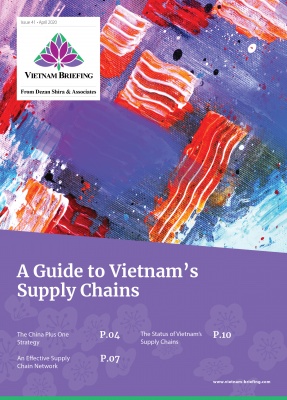
A Guide to Vietnam’s Supply Chains
Published: April 2020Vietnam’s supply chains have significantly evolved from how they were a decade ago. Today, supply chain shifts to Vietnam are ongoing, helped in some part by the US-China trade war, as a growing number of businesses seek out ASEAN or alternate markets to invest in. In this issue of Vietnam Briefing magazine, we look at ways to plan supply chain shifts while using Vietnam as a China plus one investment destination. We then look at the status of Vietnam’s supply chains and how they are developing as manufacturing in the country matures.
Vietnam’s supply chains have significantly evolved from how they were a decade ago. Today, supply chain shifts to Vietnam are ongoing, helped in some part by the US-China trade war, as a growing number of businesses seek out ASEAN or alternate markets to invest in. Among the countries competing for investment, Vietnam has emerged as a highly effective alternative for relocation in Southeast Asia.
Vietnam’s pursuit of foreign investment, competitive costs, trade agreements, and liberal investment environment have made it an ideal location for China-based investors seeking to reduce costs and diversify supply chains. Nevertheless, foreign investors considering the Vietnamese market need to have a clear understanding of the capacity and limitations of Vietnamese production.
Despite its advantages, Vietnam is not without its share of challenges. Manufacturers need to figure out how to realign their supply chains, establish which production elements to relocate, what is the market entry strategy, and understand the rules and regulations that govern Vietnam’s several trade agreements.
In this issue of Vietnam Briefing magazine, we examine Vietnam’s supply chain network. We look at ways to plan supply chain shifts while using Vietnam as a China plus one investment destination. We then look at Vietnam’s free trade network, the advantages and disadvantages of investing in the country along with rules of origin guidelines. We conclude with the status of Vietnam’s supply chains and how they are developing as manufacturing in the country matures.
This magazine is based on Dezan Shira & Associates’ years of experience in supporting foreign enterprises in Vietnam, including facilitating supply chain shifts during an infectious disease outbreak, such as COVID-19.

